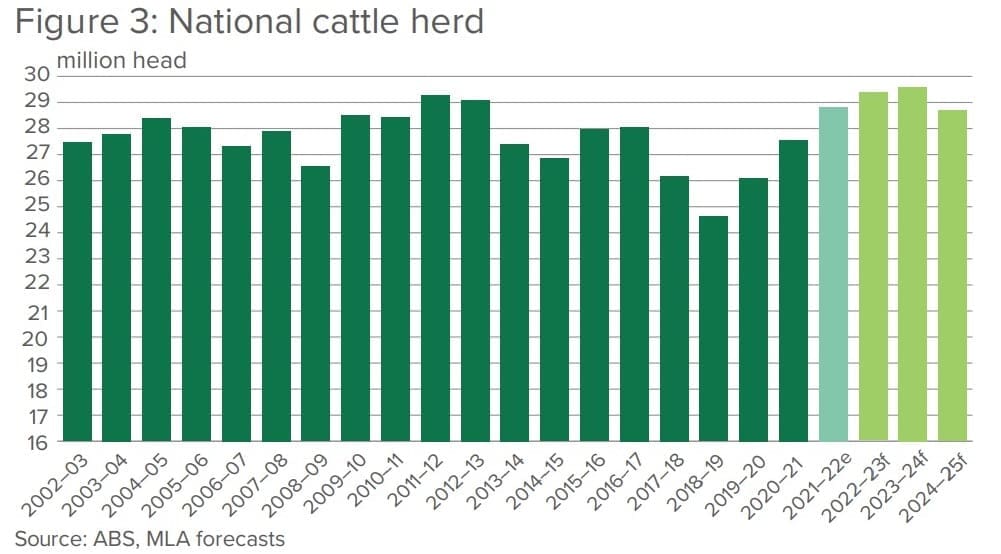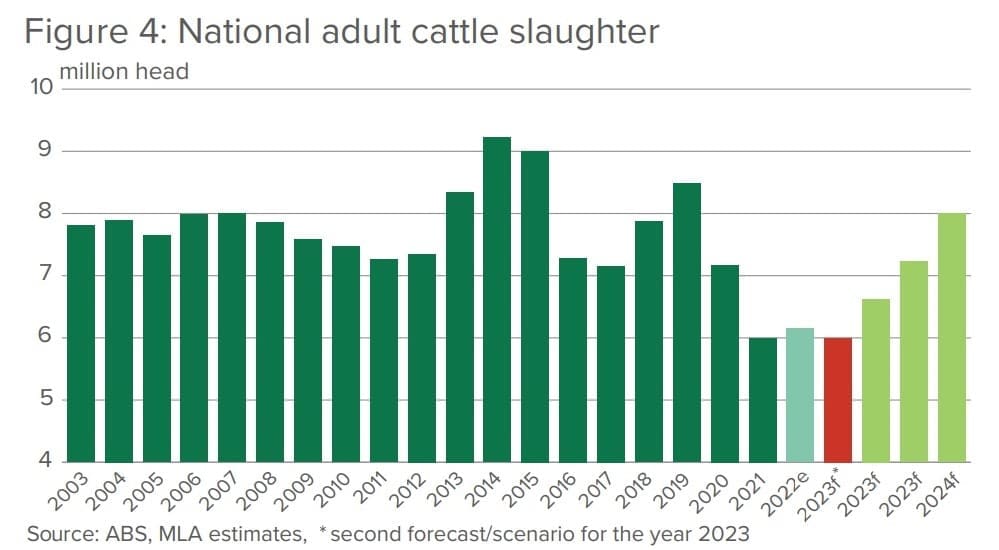
BOOSTED by rapid herd recovery after three successive years of above average seasonal conditions following the 2019-20 drought, Australia’s cattle herd has reached its largest size since 2014.
National cattle numbers are now at 28.8 million head, Meat & Livestock Australia estimates in its 2023 beef industry projections issued this morning. However some independent analysts have already branded the projection ‘heavily optimistic.’
The correction on supply/demand after the herd earlier hit a 32 year low due to drought liquidation, is likely to see cattle prices closer to longer term averages in 2023, MLA forecasts.
As this earlier article suggests, issues surrounding labour remain the key determinant of cattle slaughter performance in 2023, MLA says.
The Australian Beef industry and cattle herd are well positioned to capitalise on changing global supply dynamics in 2023, its says.
“This year will be a year of transition and maturity for Australia’s cattle herd, with any increases in numbers now beyond rebuild status, with all key production metrics forecast to improve this year, MLA’s senior market information analyst Ripley Atkinson said.
Continued rainfall and favourable seasonal conditions seen last year would ensure that there will be solid supply of both young and slaughter weight cattle over the next two years, regardless of seasonal outcomes, he said.
Southern Australia will continue to drive increases in cattle numbers, particularly New South Wales, with supply improvements also expected from southern Western Australia, South Australia and Victoria to different extents.
In the north, 2022 saw favourable seasonal conditions for large parts of Queensland, driving the beginning of the state’s herd rebuild and an improvement in female numbers. Northern Australia’s rebuild is expected to gain significant pace this year. The 2019-20 drought extended six months longer in many parts of Queensland than it did in southern regions.
In assumptions around weather impact, the Projections report says early forecasts suggested that El Niño will begin by June 2023. If this eventuates, significant herd liquidation was not expected until late 2023 or early 2024.
Overall, the national cattle herd will increase by 1.1 million head or 4.5pc year-on-year, MLA said.
Mr Atkinson said this growth was being underpinned by a few key factors.
“The record retention of females for 15 consecutive months, coupled with above-average branding rates has delivered larger calf drops. This bodes well for supply to increase substantially in 2023 for both young and slaughter-weight cattle,” he said.
“Both of these metrics suggest that the lowest or most significant retention of stock on record occurred for the year. This underpins the positive growth in numbers forecast for the next three years.”
By 2025, the national herd is expected to reach its highest level since the 1970s at 29.6 million head, before a steady decline. This continued growth is due to strong female reproductive performance, genetic improvements across the herd and sound on farm management.
Input prices and cost of production will be major factors affecting the ability of the sector to remain productive and efficient.
In addition, the availability of skilled and unskilled workers to manage the increased supply of cattle in 2023 will be the major issue affecting the red meat processing industry. The processing sector’s ability to process cattle will determine production levels and therefore exports in 2023.
As a result, two separate scenarios have been prepared for the 2023 forecast.
If labour concerns are not addressed within the processing sector, slaughter is forecast to reach six million head (red bar on the graph below), whereas based on actual supply of cattle this year (lime-green bar), the forecasts indicate an uptick in numbers to 6.625 million head, before growing to 7.22m a year later.

Average carcase weights in adult slaughter cattle this year are expected to decline by 5kg to 315kg, partly due to greater use of grass finishing. Weights are anticipated to continue to decline in 2024 (308kg) and 2025 (302kg) as an increasing proportion of cattle are finished on grass.
Overall beef production this year is expected to reach2.087 million tonnes, another 119,000t up on last year. Beef exports will also rise, reaching 1.49 million tonnes, up another 110,000t on last year, before reaching 1.598mt next year.
The 2023 year will be one of transition for the cattle industry, Mr Atkinson said.
“Positive outcomes along the entire supply chain seem likely as the exceptional operating conditions on-farm continue. The overall outlook for Australia’s beef industry both domestically and internationally is one of optimism and positivity, while it continues to deliver high quality beef in larger volumes, this is expected to be a major feature in 2023,” Mr Atkinson said.



HAVE YOUR SAY